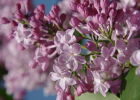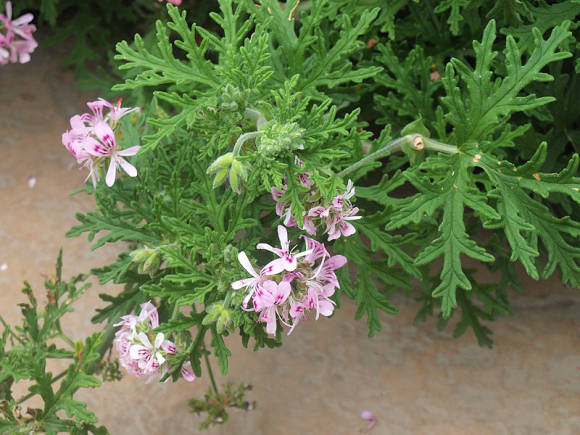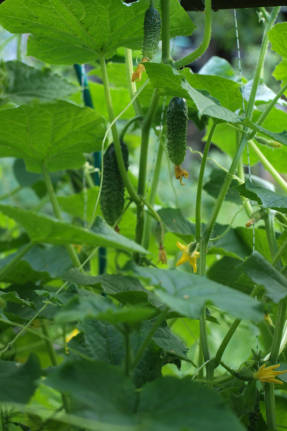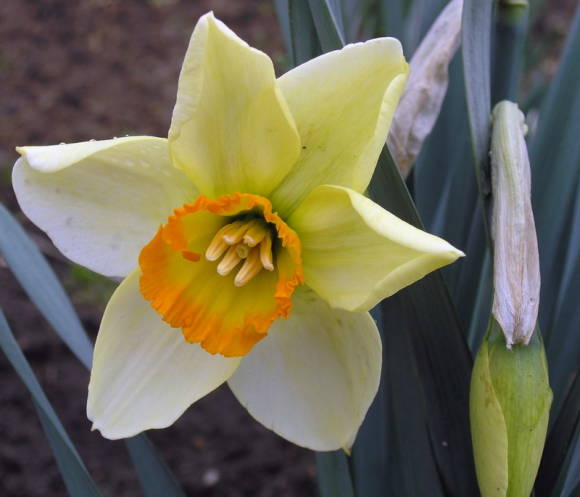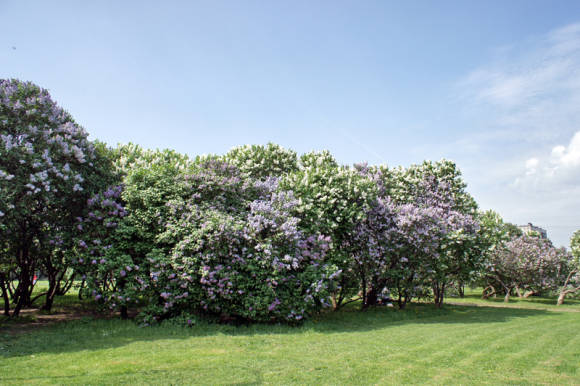
In the landscaping of Moscow, common lilac (Syringavulgaris L.) is represented very widely. This, of course, is due to the fact that it is perfectly suited for urban conditions in the temperate zone. Common lilac is a large shrub, undemanding to soil fertility, capable of tolerating frost, drought and atmospheric pollution. Moreover, it has the highest decorative effect during the flowering period - from mid-May to mid-June. However, for Moscow, lilacs are also of special cultural and historical value. It was in Moscow that the outstanding breeder of lilacs, Leonid Alekseevich Kolesnikov (1894-1968), lived and created new varieties. As a result of his large-scale activity, many lilac bushes, both varieties and numerous seedlings, were planted in the city, which Kolesnikov did not destroy, but distributed to amateurs and used for new crosses. Thus, among the old plantings in Moscow, there may be especially valuable plants of the Kolesnikov varieties, which are considered lost or are in collections in single copies. In this regard, monitoring of such plantings is becoming increasingly important.
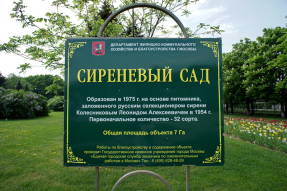 | 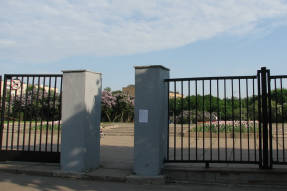 |
The most representative collection of lilacs among public gardens and parks in Moscow is the Lilac Garden, founded in 1975 on the basis of the Kaloshino nursery, founded by L.A. Kolesnikov in 1954. This garden is located in the east of Moscow at the address: Shchelkovskoe shosse, vl. 8-12. Currently, it is a public landscaping facility owned by Moszelenkhoz. The territory of the Garden with an area of 7 hectares is occupied by a lawn covering with a system of unpaved, tiled and asphalt paths. In the landscaping there are flower beds and a small number of tree species located mainly along the periphery of the site. Lilacs in the "Lilac Garden", of course, play a special role, for a more complete understanding of which historical information is needed.
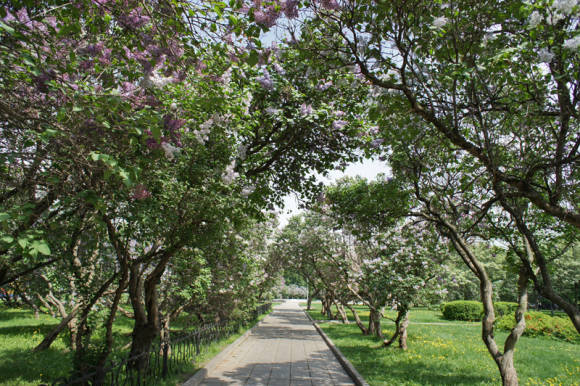
The first lilac plants in this area were planted in 1954 with the direct participation of L.A. Kolesnikov, who at that time took over the position of technical director of the Kaloshinsky nursery of the Moscow City Trust of Greenhouses and Nurseries. These were adult bushes - mother plants of varietal lilacs and hybrid seedlings, as well as oculants and rootstock material from the famous garden of L.A. Kolesnikov in Bolshoy Peschaniy Lane (Sokol metro area), which he donated to the state back in 1952, immediately after he was awarded the Stalin Prize "for developing a large number of new varieties of lilacs." At the same time, the Government and the Executive Committee of the Moscow City Council decided to create an experimental breeding nursery in Kaloshino. 11 hectares of land were allocated for the lilac nursery - an uncultivated wasteland. More than 2,000 lilac bushes were transported from the garden on Sokol to Kaloshino. In 1956, Kolesnikov was transferred to the position of director of the nursery. From his surviving memorandum, one can get an idea of the difficulties in the activity of this nursery, despite which he continued breeding work and activities to popularize new varieties of lilacs. In 1962, Kolesnikov was retired, and he again works with lilacs at his old site.
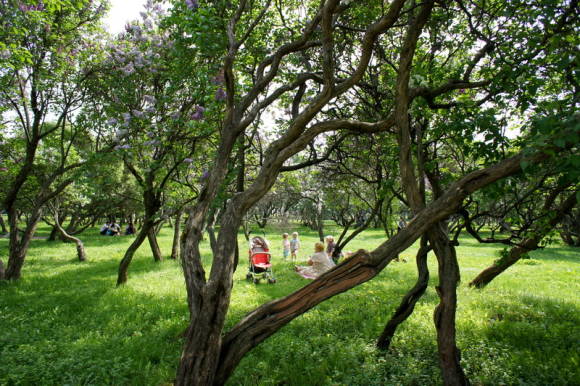
Meanwhile, both gardens - both on Sokol and in Kaloshino, were under threat of destruction in connection with the decision to start construction of residential buildings on their territory. Omitting the tragic details here, I can only say that all the remaining lilacs from the garden on Sokol, at the request of Kolesnikov, in 1966 were moved to the Shchelkovskoe highway, but at an inappropriate time and with violations of agricultural rules. As a result, only 80 bushes have taken root in the new place, some of which have survived to this day, and some have died.[1] As stated on the information board at the entrance to the Garden, "the original number of varieties - 32".
Soon the nursery "Kaloshino", where all the planned work had not yet been completed, was included in the nearest Pervomaisky state farm of decorative crops as an "experimental nursery", and then transformed into a public gardening object, which still exists today.
During the improvement of the territory of the "Lilac Garden", a redevelopment of the site was carried out, as a result of which additional roads were laid through the quarters planted with lilacs. Plants that ended up on the site of the roads under construction were moved in groups to open areas of the Garden, occupied by a lawn. The transplantation scheme was not made, and therefore the plants in the groups are not tied to the plan by varieties, but there is only a general list. Thus, the collection of lilac cultivars in the Lilac Garden cannot be recognized as a full-fledged collection, despite the fact that it is here that the original specimens of lilacs from L.A. Kolesnikov.
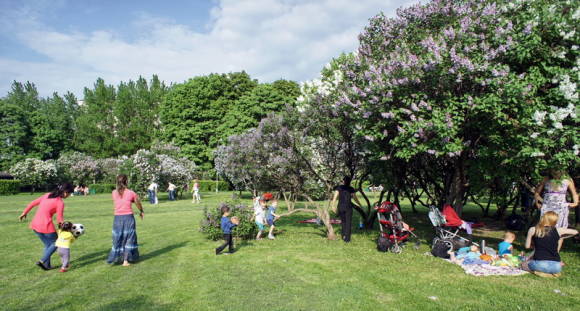
Inventory results
The previous inventory of lilac plantings in the "Lilac Garden" on the Shchelkovskoye Highway was made in 1984. In 2011, as part of her graduation work in the Garden, a 6th-year student of the Faculty of Gardening and Landscape Architecture of the RSAU-Moscow Agricultural Academy named after V.I. K.A. Timiryazeva A.B. Dudnikov. Her task was to make an inventory of common lilacs at the "Lilac Garden" facility with drawing up an inventory plan, assess the state of cultivars and identify the most recognizable varieties. The inventory was carried out on the basis of the approved situational plan (scale 1: 2000) and the inventory plan of the territory of 2006 (scale 1: 500), taken at the enterprise serving this facility (Gorzelenkhoz No. 5).
An inventory plan was drawn up with the application of all surveyed lilac plants with their numbers. For the convenience of carrying out the work, A.B. Dudnikova divided all plantings of common lilac into groups, which were numbered and plotted on the inventory plan. Within the groups, all specimens of lilacs were numbered. For the correct location of the groups and each lilac plant on the plan, they were linked to the terrain (asphalt paths, fence, etc.).
From the surviving working journal of L.A. Kolesnikov, it is clear that initially in this territory he laid 16 rows, in which there were 74 seats. But now in ordinary landings there are the same 16 rows, in which there are only 38 seats. The results of the inventory showed that since 1984, 166 lilac plants have died in the row planting. As of May 2011, 872 specimens of lilacs are represented in the Lilac Garden, of which 248 are located in ordinary plantings, 616 in group plantings and 8 in single plantings.
In 2011, on May 18, a commission consisting of I.B. Okuneva, curator of the lilac collection of the GBS RAS, T.V. Polyakova, Vice-President of the International Lilac Society for Russia and Asia and representatives of the "Lilac" section of the "Flower growers of Moscow" club headed by its chairman T.A. Veremieva examined the Lilac Garden object to assess the varietal conformity and condition of lilac plants.
Definition of varieties
The lilacs of the Lilac Garden collection can be roughly divided into 4 groups:
1. foreign varieties that L.A. Kolesnikov used in crosses;
2. registered varieties bred by Kolesnikov;
3. promising seedlings and seedlings used for crossing;
4. undefined cultivars (no number).
Based on the comparison of the new inventory plan with entries from the journal L.A. Kolesnikov, it was found that today in the Garden there should be 23 varieties of L.A. Kolesnikov and 20 varieties of foreign selection, as well as hybrid seedlings - 99 pcs. and unspecified varieties (no number) - 104 pcs.
It should be noted that it is possible to reliably determine the variety of lilacs only in those cases when it has bright unique features, for example, a border along the edge of the petal in the Dzhambul variety, or their complex, such as lilac-pink double flowers with a specific bend of the petals in combination with purple -brown color of the bark of annual increments in the variety Olympiada Kolesnikova. Having a list of varieties from which to choose, and a planting scheme, one can confidently assert whether the plant corresponds to the variety under which it is listed or not. Although even under such conditions, difficulties are possible. In this case, the task was complicated by the fact that the plantings contain a significant number of seedlings that do not have a description and exist in a single copy. In addition, Kolesnikov did not keep strict records in his breeding work and did not leave systematic records. Only a few scattered leaves, written in pencil, have survived, on which you can find descriptions of some varieties, their numbers or names. In addition, most of the archive has been irretrievably lost.

As a result of the work of the commission, 13 varieties were reliably identified.
- In ordinary landings: Belle de Nancy, Furst Bulow, Buffon, Marshal Zhukov, Sky of Moscow, Valentina Grizodubova, Kolkhoznitsa, K.A. Timiryazev, Hortense, Olympiada Kolesnikova, Beauty of Moscow. The rest of the varieties require more detailed examination and clarification.
- In group plantings, the identification of varieties is very difficult, due to the fact that there are many hybrid seedlings among cultivars. They identified only two well-recognized varieties: Charles Joly; Captain Gastello.
- In single plantings, one cultivar is defined - Buffon.
- Presumably (based on the color of the corolla) a seedling called Cream was also identified.
Varieties L.A. Kolesnikova The Beauty of Moscow, Olympiada Kolesnikova, Heaven of Moscow and Hortense are widespread enough and their fate is currently not a cause for concern. Varieties of Marshal Zhukov, K.A. Timiryazev and Kolkhoznitsa are of particular value, since they are either absent in the collections, or under this name there are cultivars that do not correspond to the description, which were mistakenly multiplied and distributed.
Some plants could not be identified because at the time of the survey their buds had not yet opened. This work is planned to be continued.
Plants condition
All lilac plants were assessed by condition categories in accordance with the Methodology for conducting an inventory of green spaces. To indicate the condition of each instance, the criteria for assessing the condition by points from 0 to 6 were used:
0 - good condition (no signs of weakening);
1 - satisfactory (weakened);
2 - satisfactory (strongly weakened, in the crown from 25% to 50% of dry branches);
3 - unsatisfactory (strongly weakened, in the crown from 50% to 75% of dry branches);
4 - unsatisfactory (drying out);
5 - unsatisfactory (dead wood of the current year);
6 - unsatisfactory (dead wood of past years).

Of the total number of lilac specimens (872), only 1% is in good condition. 17% of the lilacs received a satisfactory mark (1 point). Most of the lilac bushes are rated at 2 (38%) and 3 (33%) points, that is, in fact, the plants are in an unsatisfactory condition, to a greater or lesser extent weakened, they have damaged trunks, in the crowns from 25% to 75% dry branches. 9% of lilac plants are on the verge of death (4 points - dying out). Plants, the condition of which is assessed as satisfactory, still grow normally, but no longer have a high decorative value, are partially affected by diseases, and have mechanical damage.
The exact age of the plants is unknown; in the oldest, by external signs, it can be determined at about 80-100 years, which is consistent with the archival data. Judging by the appearance of plants, since the cessation of L.A.Kolesnikov, i.e. for about 50 years, there was no special care for lilac bushes. Garden maintenance consisted mainly of mowing lawns, arranging and maintaining flower beds and paths, and pruning was reduced to sanitary, probably carried out as needed, when broken and dried branches and trunks were removed, which can be seen when inspecting the plants. Without rejuvenating and supportive pruning, which stimulates the formation of new growths from the base of the bush, the gradual replacement of aging stems with young ones does not occur, and the existing old stems are already close to dying off [2, 3]. Unfortunately, for such old bushes, rejuvenation by pruning is dangerous, and one can only count on the development of spinning shoots from dormant buds that can at least partially restore the plants.
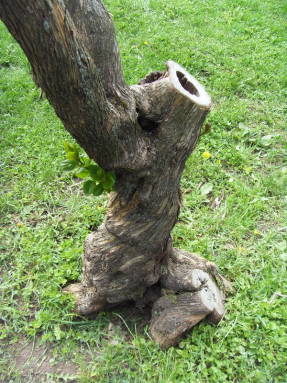 | 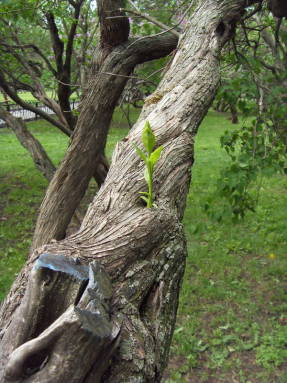 |
This situation is aggravated by the fact that the visitors of the Garden use the lilac trunks bent in a natural way from old age for sitting, which increases the load on the plants and leads to mechanical damage to the trunks. On the territory of the "Lilac Garden" with an area of 7 hectares there are only 9 benches and 18 urns, which does not correspond at all to the number of visitors, especially numerous during the lilac bloom.
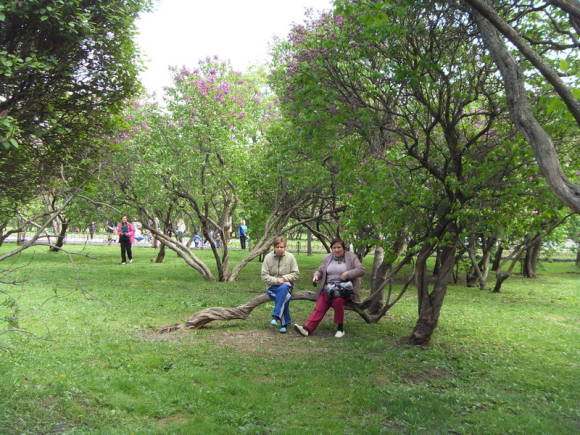
No less, and perhaps more dangerous, is the barbaric breaking off of inflorescences by visitors, from which lilacs in Moscow suffer everywhere. Such breakages interfere with the normal development of the crown and lead to ugly branching disorders and the appearance of stem defects. Since the largest inflorescences are located in the upper part of the bush, attempts to get them almost always end in breaking off large branches and even whole trunks.
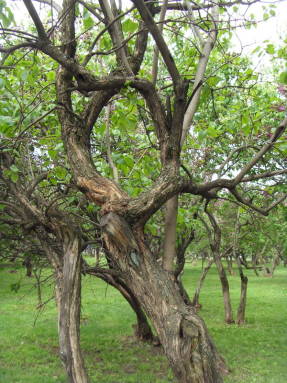 | 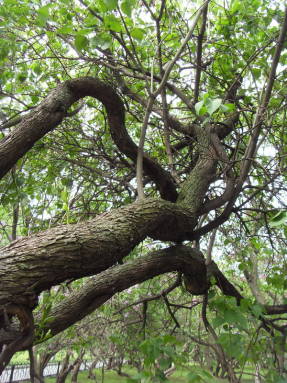 |
 | 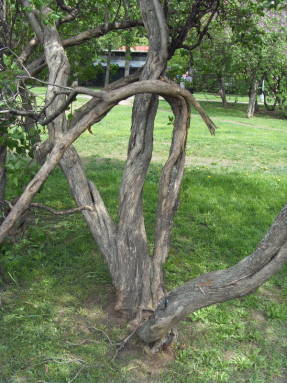 |
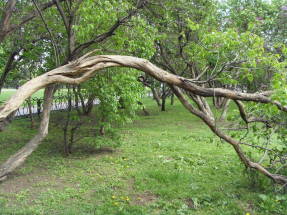 | 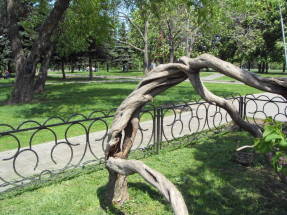 |
In group plantings, there are specimens of lilacs of a younger age. Among them there are many grafted plants with lost rootstock shoots that have reached a blossoming state. If the rootstock trunks are not removed in the coming years, it will drown out the cultivated graft. Such pruning should be carried out by or under the supervision of qualified personnel. To carry out pruning, the permission of the company serving the object is required.
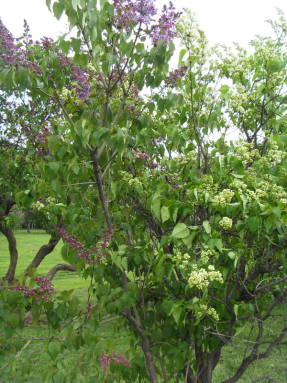 | 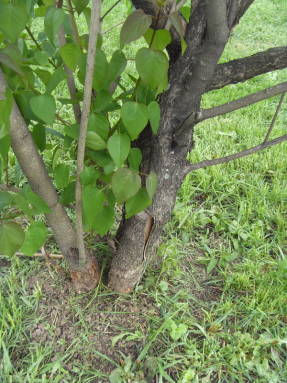 |
Thus, on the basis of the results of the survey of the Lilac Garden object, it can be concluded that in order to preserve the varietal lilac plants planted by L.A. Kolesnikov, it is necessary to take measures to protect the bushes from damage by visitors to the Garden and provide qualified care for the lilacs. The installation of additional benches and trash bins can also help reduce anthropogenic pressure on plants of historical value.
Literature
1. Polyakova T. History of Russian lilac. In memory of Kolesnikov - M., "Penta"; 2010.200 s.
2. Hump V.K. Rejuvenation of plants of common lilac varieties. // Biological and ecological features of introduced plants, 1985, - p. 39-43.
3. Okuneva I.B. Lilac. M .: "Kladez-Buks", 2006.
